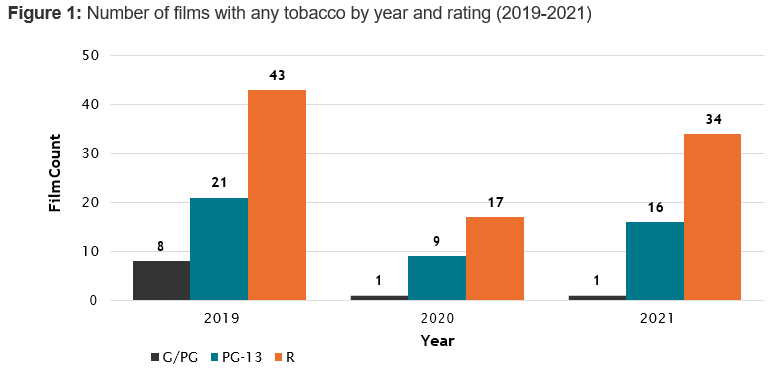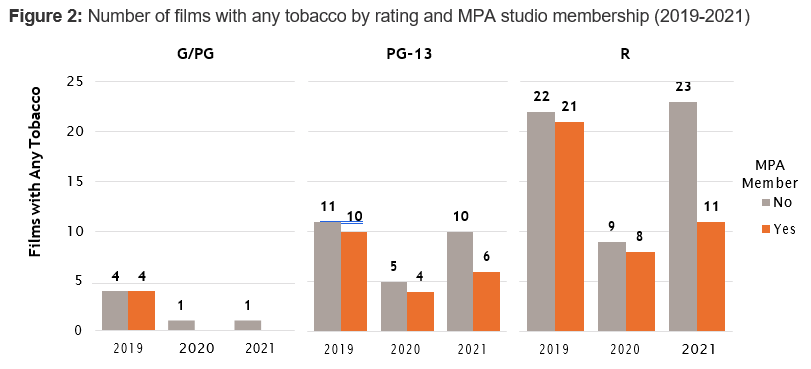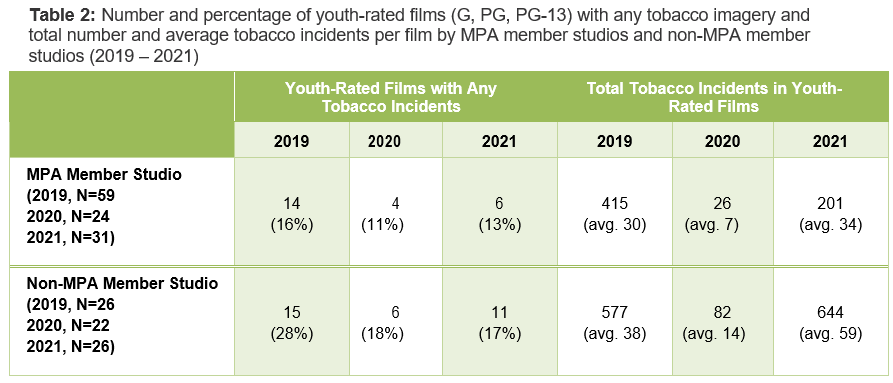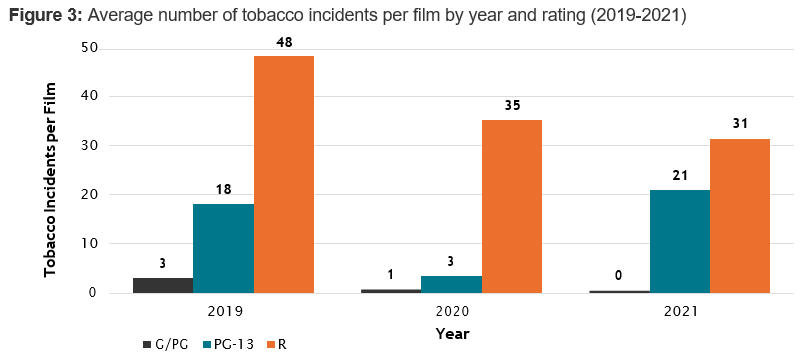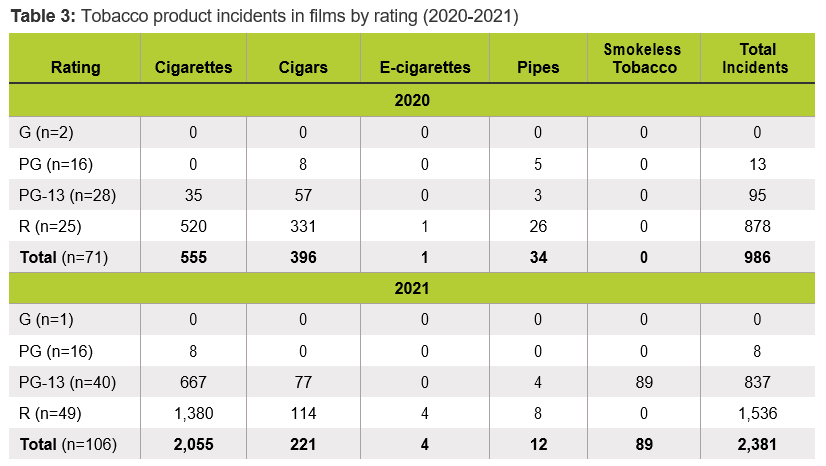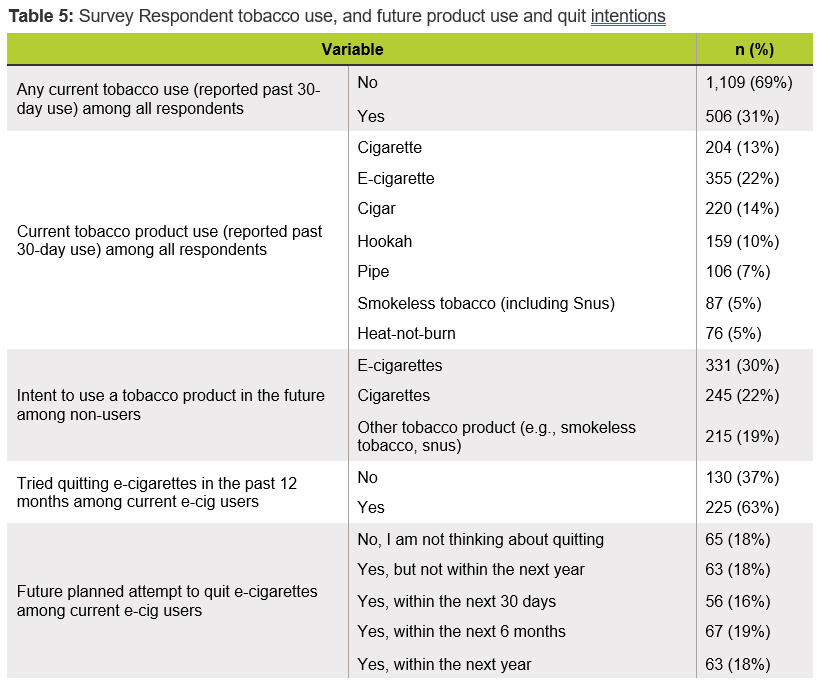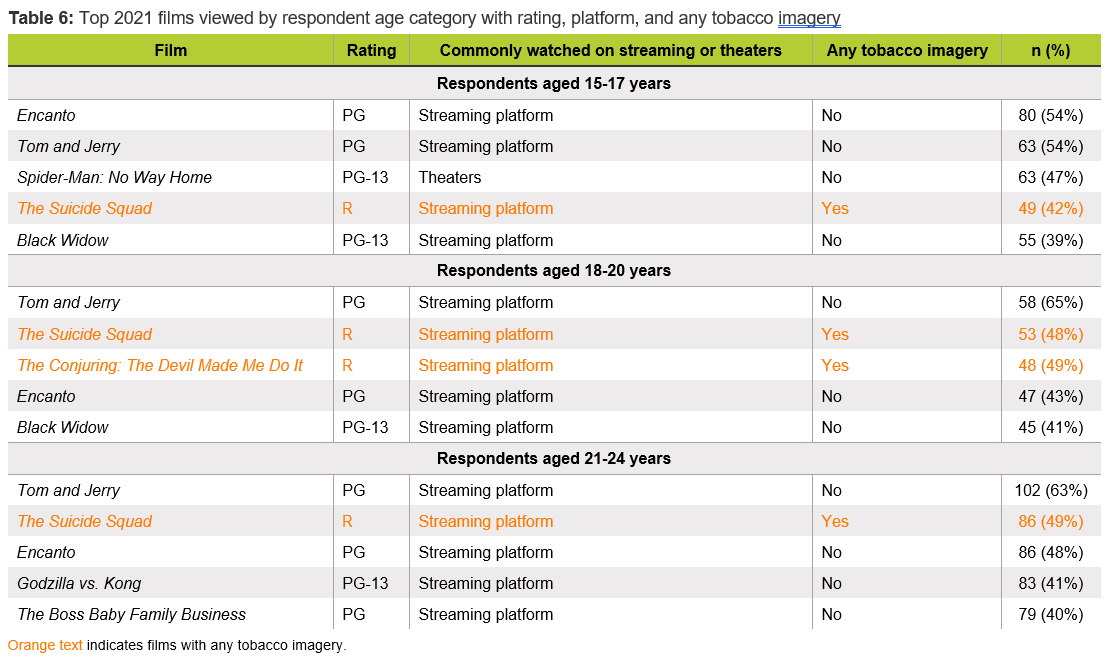Smoking in Films: 2021
This report is by researchers at NORC at the University of Chicago.
The Centers for Disease Control and Prevention (CDC) estimated films would recruit approximately 6.4 million new US smokers among projected American smokers aged 0-17 in 2014. Almost 90% of those who initiate smoking due to onscreen exposure start smoking before age 18, with 2 million ultimately dying from tobacco-induced diseases, such as heart disease, lung cancer, stroke, and emphysema. Similarly, a 2021 study by Truth Initiative® found that youth and young adults with high exposure to popular streaming and TV shows containing tobacco images were three times more likely to start vaping. A separate study found that youth who had previously used e- cigarettes were more than four times more likely to ever use cigarettes compared to peers with no prior tobacco use. Thus, reducing kids’ exposure to onscreen tobacco use may significantly reduce youth initiation of tobacco use. The evidence base is growing and repeatedly confirms what United States (U.S.) tobacco companies have known since the late 1920s: movies sell tobacco.

Youth and young adults with high exposure to popular content containing tobacco were three times more likely to start vaping.
In 2003, researchers, state Attorneys General, and policymakers put the Motion Picture Association of America (MPA) on notice of the need to eliminate youth exposure to smoking on screen. However, to date, the film industry has only taken modest steps to reduce or enforce stricter regulations or exclude tobacco imagery in youth-rated (G, PG, PG-13) films. The MPA represents six major film studios in the U.S: Walt Disney Motion Pictures, Paramount Pictures, Sony Pictures Entertainment, Universal City Studios, Warner Brothers Entertainment, and most recently, Netflix. Non- MPA movie studios are comprised of other production companies not part of the MPA and include large studios with publicly traded parent companies and smaller independent studios. Examples of non-MPA member studios are Lions Gate Entertainment, STX Films, and BRON Studios, among many others.
As discussed in our 2020 films report, the COVID-19 pandemic hit the U.S. in early 2020 and drastically changed how films were released and watched. As an adaptation of the pandemic, we saw an exponential rise in films released straight-to-streaming (on services such as HBO Max, Disney+, and Amazon Prime), and people were more likely to watch newly released films on these streaming services than in theaters – a trend that continued into 2021. This change had important implications on our methodology used for these annual reports since streaming companies do not make their viewership data publicly available, which limits our ability to measure audience exposure and impacts.
This year, to address this gap, we fielded a survey with youth and young adults to capture and quantify exposure to tobacco imagery in popular films released in 2021.
Since 2002, the University of California, San Francisco has collaborated with Breathe California and Truth Initiative to analyze onscreen smoking data in the Breathe California Onscreen Tobacco Database and produce annual reports summarizing tobacco presence in top films released that year. In 2021, NORC at the University of Chicago joined the collaborative effort, taking over the analysis and reporting role starting with the 2020 report. The new survey data in 2021 builds and supplements the Smoke Free Media Onscreen Tobacco Database, which collects and archives film information, including company and production credits and tobacco product count in films. This report highlights findings from both data sources and discusses evolving changes and implications for this research moving into 2022 and beyond.
Top Films Released in 2021
We identified top films released in 2021 if they appeared at least once on Box Office Mojo’s Top 10 chart lists. We included 112 films released in 2021 and available to watch in the domestic United States for analysis in this annual report. Table 1 displays the breakdown of 2021 films by rating and MPA member studio production company affiliation. Please visit the Smoke Free Media Onscreen Tobacco Database for more details on the films, including film name, release date, company credits, and tobacco measures.
Of note, six top films released in 2021 had a “Not Rated” or absent rating designation, and we excluded these films in any analyses by rating later in this report.
Total Number and Percentage of Films with Any Tobacco Imagery by Film Rating
The total number and percentage of 2021 films with any tobacco was 53 out of 112 films (47%). This represents a slight decline compared to 2019, with 72 out of 142 films (51%), and a 21% increase from 2020, with 27 out of 71 films (38%) (Figure 1). We might consider 2019 a more directly comparable year to 2021 since 2020 saw many changes with film release delays due to the COVID-19 pandemic. As production companies moved beyond the pandemic, there was a 21% increase in the number of films released with tobacco from 2020 to 2021 (38% in 2020; 47% in 2021).
Tobacco imagery across all films is problematic, but the continued portrayal of harmful tobacco imagery in youth-rated (G, PG, and PG-13) films is especially detrimental. In 2021, while most top films containing tobacco were rated R (n=34 films), 17 youth-rated films – one PG-rated and 16 PG-13-rated –included tobacco imagery. The Girl Who Believes in Miracles (Trailmaker Production; Non-MPA studio) was the only PG-rated film containing tobacco. Appendix A contains a complete list of youth- rated films with tobacco. Tobacco imagery continues to pervade youth-rated films, despite fluctuations in the number of films produced per year. In 2019 there were 29 youth-rated films with tobacco and ten youth-rated films with tobacco in 2020. The lower number of youth-rated films with tobacco in 2020 may be due to the lower number of total films released that year, likely due to the pandemic, which caused delays in production and film releases.
Total Number and Percentage of Films with Any Tobacco Imagery by MPA and Non-MPA Film Studios
Non-MPA production companies in 2021 accounted for more than half of all films with any smoking and tobacco across rating categories (G/PG: 4 of 8 films; PG-13: 11 of 21 films; R: 22 of 43 films) (Figure 2), a trend we first observed in 2019. Non-MPA studios also continue to release more youth-rated films with tobacco imagery and, on average, have more tobacco incidents per film than MPA member studio films. Our findings indicate the following:
- For the past three years, non-MPA studios have consistently released more youth-rated films featuring tobacco than MPA studios (Figure 2).
- Non-MPA member studio films also had a higher number of total tobacco incidents in youth-rated films for the past three years (644 total tobacco incidents in youth-rated films released by non-MPA member studios vs. 201 total tobacco incidents in youth-rated films released by MPA member studios in 2021) (Table 2).
- For the past two years (2020 and 2021), MPA member studios have not released any G/PG-rated films containing (Figure 2) and had the lowest number of PG-13 and R-rated films with any tobacco.
Production companies Walt Disney Studios, Warner Bros., and MGM Holding produced the most number of 2021 films overall with any tobacco. Specifically, among MPA studio members, Walt Disney Studios, Warner Bros., and Sony Pictures produced the most number of 2021 films with tobacco. MGM Holdings, BRON Media Corp, and Millennium Media are the non-MPA studios that produced the most number of 2021 films with tobacco.
Table 2 presents a spectrum of granularity when examining youth-rated films with tobacco imagery and their respective average volume of tobacco incidents. First, we present the total number of MPA member youth-rated films by year at a high level (e.g., N=31 youth-rated films in 2021). Second, "Youth-Rated Films with Any Tobacco Incidents" takes the total number of youth-rated films containing tobacco over the total number of youth-rated films each year by MPA status (e.g., six youth-rated films, or 13% of all youth-rated films from 2021 containing any tobacco come from MPA member studios). "Total Tobacco Incidents in Youth-Rated Films" examines total tobacco incidents in youth-rated films over the number of youth-rated films that contained tobacco (e.g., MPA member studios accounted for 201 tobacco incidents in youth-rated films containing tobacco in 2021, which is 34 films on average among youth-rated films containing tobacco).
Total Number of Tobacco Incidents in Films by Rating
There were 2,386 total tobacco incidents in the top 2021 films. This number more than doubled from 986 total incidents in 2020 films. Tobacco incidents are the number of times tobacco products (e.g., cigarettes, cigars, e-cigarettes, smokeless tobacco, and pipe products) appear in a film. We often divide tobacco incidents by the number of movies each year, either containing any tobacco or not, to determine the average number of tobacco incidents per film and to account for fluctuations in the number of films released annually. Across all top films containing tobacco, the number of tobacco incidents per film came to 45 incidents per film, among films containing tobacco, on average for 2021, compared to 37 incidents per film on average for 2020 and 50 incidents per film on average for 2019.
Youth exposure to harmful tobacco imagery in films still exists. For example, The Marksman (PG-13 rating; Cutting Edge Group; Non-MPA) contained 313 total tobacco incidents, the most among all youth-rated films in 2021. The average number of tobacco incidents per film in G/PG- and R-rated films declined in 2021 compared to prior years and increased in 2021 from 2020 for PG-13-rated films (Figure 3). Notably, R-rated films continue to contain the highest number of tobacco incidents per film, with 31 incidents per film in 2021.
Tobacco Product Imagery in Films
As the tobacco product landscape grows, products such as electronic cigarettes (e-cigarettes), cigars, and pipe tobacco have made their way into mainstream media in both youth and R-rated films. We also witnessed a resurgence in traditional combustible tobacco products. In 2021, of 2,381 incidents of tobacco products in 106 rated films, cigarettes accounted for 2,055 incidents (86%) and were the most common tobacco product displayed (Table 3).
In 2021, there was an increase in the number of smokeless tobacco and e-cigarette product incidents compared to 2020 films. Smokeless tobacco products appeared in two 2021 films, the Marksman (PG- 13 rating; Cutting Edge Group; Non-MPA; 85 incidents) and Minari (PG-13 rating; Plan B Entertainment; Non-MPA; 4 incidents), totaling 89 incidents, up from zero films in 2020 that contained smokeless products. Perhaps surprisingly, for the second year in a row, there were minimal incidents of e-cigarettes in 2021 films (four incidents in four different films, up slightly from only one incident in one film in 2020), despite its saliency in other media popular with youth (e.g., television and social media). R-rated films continued to contain the greatest number of tobacco incidents, and there were no G-rated films that depicted tobacco products. The Girl Who Believed in Miracles (PG-rating; Trailmaker productions; Non-MPA studio) was the only PG-rated film with tobacco imagery and contained all eight incidents of cigarettes for 2021 PG-rated films.
Audience Exposure to 2021 Films with Tobacco: Box Office
Before the COVID-19 pandemic in March 2020, the Tobacco in Top Films methodology used total box office revenue and U.S. average ticket sale prices to estimate audience exposure to in-theater tobacco imagery. However, in 2020, film-watching behaviors changed as theaters across America closed their doors. With the resumption of in-theater film viewings in 2021, using the historical methods only partially account for population-level exposure to tobacco in films. Production companies have continued to utilize other modes to release new films (e.g., straight to streaming or concurrent theatrical and streaming release).
At the time of writing this report, the 112 top films released in 2021 amassed $4.8 billion in total domestic box office revenue, and the average ticket price in the United States was $9.17. Approximately $1.3 billion (28% of total domestic box office revenue) originated from films containing tobacco (films without tobacco amassed approximately $3.4 billion or 72% of total domestic box office revenue). Among all 2021 top films with any tobacco imagery, those with a PG-13 rating produced the most box office revenue (approximately $760 million or 16% of total domestic box office revenue;).
Top box office films in theaters in 2021 exposed an estimated 146 million youth and adults to tobacco imagery. In calculating a gross estimate for exposure, we used a national average for ticket price and gathered box office revenue data for films containing any tobacco from IMDB Pro (third-party) to calculate this value. This method for calculating in-theater exposure assumes each viewer is a unique individual and does not account for duplicate viewings, thus lacking specificity. Further, we currently do not have demographic data on ticket purchases (e.g., age, geography, gender, race/ethnicity), making it difficult to determine the composition of individuals watching films in theaters, namely extracting youth viewership of onscreen tobacco.

An estimated 146 million youth and adults were exposed to tobacco imagery in top films watched in theaters in 2021.
Youth & Young Adult Survey Respondents
The rise in releasing films directly to streaming or concurrently in theaters and the lack of viewership data made available by streaming companies pose challenges in estimating audience exposure. As a result, NORC, in collaboration with the Truth Initiative, fielded a survey among youth and young adults to measure viewership of top films in 2021 and supplement our traditional theater measures using box office estimates. We fielded our survey in May 2022 and asked 1,615 youth and young adults, ages 15- 24, to indicate which 2021 films in the Smoke Free Media Onscreen Tobacco Database they watched and whether they first watched the film in theaters or on a streaming service, if at all. Our survey also collected respondent-reported data on demographics, tobacco use intentions, current tobacco use and quitting behavior, and overall media consumption. Survey respondents were largely 21-24 years (44%), female (52%), identified as heterosexual (64%), not of Hispanic origin (56%), and white or European American (39%), followed by Black/African American (30%). Appendix B contains a detailed table of survey respondent demographics.
Our survey also captured youth and young adult tobacco use behaviors. We asked participants questions about their past 30-day tobacco use, intention to use a tobacco product in the future, and intentions to quit among current users, with results outlined in Table 5. Most participants reported not using tobacco in the past 30 days (69%). However, a large volume of respondents (506 or 31%) indicated they were current tobacco users, meaning they had used any tobacco product more than once in the past 30 days. Among current users (n=506), 22% reported using an e-cigarette, 14% reported smoking a cigar, 13% reported smoking a cigarette, 10% reported hookah use, 7% reported smoking tobacco in a pipe, 5% reported using smokeless tobacco (including Snus), and 5% reported using a heated tobacco product.
Results from our survey revealed that approximately 30% of youth and young adults who are not current tobacco product users intend to use e-cigarettes in the future (n=331), and 22% of youth and young adult non-users intend to use cigarettes in the future (n=245). When asked about previous attempts to quit e-cigarette use, 63% of current e-cigarette users indicated they made a quit attempt in the past 12 months (n=225). When asked about a future quit attempt among current e-cigarette users, 18% are not planning to quit (n=65), 16% are planning to quit in the next 30 days (n=56), and 36% intend on quitting in the next six months to one year (n=130).
Audience Exposure to 2021 Films with Tobacco: Survey
From a randomized list of 30 2021 films, our survey asked youth and young adults to select the films they watched and where they first watched them (in theaters or on streaming platforms). Table 6 displays the top 2021 films watched by each age group. The films most viewed by youth and young adults overall include Tom and Jerry (n=223; PG Rating; Warner Bros.; MPA member studio), Encanto (n=214; PG rating; Walt Disney Studios; MPA member studio), the Suicide Squad (n=198; R rating; Warner Bros., MPA member studio), Godzilla vs. Kong (n=174; PG-13 rating; Legendary Entertainment; Non-MPA studio), and Spider-Man: No Way Home (n=174; PG-13 rating; Columbia Pictures; MPA member studio). Among these top watched films, survey respondents reported viewing only one predominantly in theaters: Spider-Man: No Way Home, indicating the preferred use of streaming platforms over in-theater viewings to watch newly released movies among the majority. This film is now one of the highest-grossing films of all time and one of few films to cross the $1 billion mark worldwide during the COVID-19 pandemic16.
The top watched films by age group mirrored those viewed by the entire sample, with Encanto being the top watched film among respondents ages 15 to 17, while Tom and Jerry was the top film for respondents ages 18 to 24. Youth and young adults watched top films without tobacco more frequently than films with tobacco (Table 6). Among the top five watched films overall, only one film, the Suicide Squad, contained tobacco (42% of respondents aged 15-17 reported viewing the film; 48% among those aged 18-20; and 49% among those aged 21-24).
We found no strong relationships when we analyzed our data to examine trends in films with tobacco imagery watched by youth and young adults by their tobacco use behaviors (current users, non-user with no intent to use, and non-user with intent to use). However, we noticed non-current tobacco users who reported an intent to use a tobacco product in the future watched slightly more top films containing tobacco than non-users with no intention to use a tobacco product. Our results found that two of the top five films viewed by non-users with intention to use contained tobacco imagery compared to only one out of top five films viewed by non-users with no intention to use contained tobacco imagery.
An estimated 25 million youth and young adults potentially exposed to tobacco imagery in top films watched on streaming platforms in 2021.
We calculated a gross estimate of potential exposure to tobacco imagery on streaming platforms among youth and young adults. First, we used our survey responses to determine the percentage of respondents viewing at least one film containing tobacco on a streaming platform. Approximately 64% of survey respondents viewed at least one film with tobacco on a streaming platform. We then applied this value to the number of youth and young adults aged 15-24 as part of the 2020 American Community Survey (ACS) five-year estimates to calculate a gross estimate of youth exposed to tobacco imagery on a streaming platform. In the 2020 ACS five- year estimate, there were approximately 38 million Americans in our desired age group (15-24 years). This method estimated that films on streaming platforms expose approximately 25 million youth and young adults to tobacco imagery. Additionally, through our calculations, we also discovered that each respondent had on average two views of films containing tobacco on streaming.
Our described methodology to calculate a gross estimate of tobacco imagery exposure among youth and young adults is an underestimate of the true magnitude of exposure to tobacco imagery through streaming platforms and comes with several limitations. First, our quota sampling approach (described in the Methods section below) oversampled for racial and ethnic minorities. Therefore, our sample is not representative, nor does it closely resemble Census data when broken down by race/ethnicity. Second, our survey did not ask each respondent the complete list of 116 films (described in detail in the Methods section). Instead, we reduced the survey burden by only showing each respondent a random block list of 30 films, ensuring each film was asked enough across survey blocks. Third, our calculated gross estimate is simply an estimate. We extrapolated the percentage of youth and young adults exposed to tobacco in films from streaming services applied to the general population. The gross estimate lacks confidence in whether this value holds true for individuals aged 15-24 years in the United States.
Conclusions
The film industry is making marginal progress over the decades towards eliminating the number of films released containing tobacco, as we see a slight decrease in the number of top films released in 2021 with any tobacco imagery. However, we continue to see youth-rated films containing tobacco imagery (n=17 films for 2021). Non-MPA member production studios remain the top offender for the greatest number of youth-rated films with any tobacco imagery and more tobacco incidents per film on average compared to MPA member production studios (MPA: 6 incidents on average per film vs. non-MPA: 25 incidents on average per film). Of the 2,381 total incidents of tobacco products in 106 rated films, cigarette tobacco products accounted for 2,055 incidents and were the most common tobacco product displayed, followed by cigars with 221 incidents and smokeless tobacco with 89 incidents. Top 2021 films containing any tobacco accounted for 28% of the top films box office revenue totals and amassed $1.3 billion of total domestic box office revenue (compared to films without tobacco, which accounted for 72% of top films and amassed $3.4 billion). An estimated 146 million youth and adults were exposed to tobacco imagery in top films watched in theaters in 2021.
In 2020, production companies adapted to the COVID-19 pandemic by delaying or releasing new films on streaming platforms. We suspected this change resulted in increased viewing of films on streaming platforms rather than in theaters. Our survey results confirmed this, with youth and young adults indicating they watched the top five most popular 2021 films on streaming platforms rather than in theaters, with the exception of youth aged 15-17 indicating they watched one film, Spider-Man: No Way Home, predominantly in theaters. Tom and Jerry, a PG-rated film without tobacco, was the most popular 2021 film watched by youth and young adults in our sample (n=223 or 51%). The Suicide Squad, an R-rated film with tobacco, was the most popular 2021 film containing tobacco watched by youth and young adults in our sample (n=198 or 40%). Additionally, 64% of survey respondents reported viewing at least one film with tobacco on a streaming platform. Approximately 25 million youth and young adults ages 15-24 were exposed to tobacco imagery on streaming in 2021, a gross estimate of exposure to tobacco on streaming by extrapolating survey results to ACS population estimates.

Future Directions
With the adjustment in film releases and viewing behaviors since the COVID-19 pandemic, we successfully fielded a survey to youth and young adults to identify top films watched and the medium used to watch them and captured tobacco imagery exposure beyond in- theater audiences. Using the survey data, we also explored the films watched across different demographics and tobacco use characteristics. Finally, we also leveraged our survey to calculate a gross estimate of the number of youth and young adults exposed to tobacco imagery in films watched on streaming platforms.
Since our first fielding, we identified opportunities to curate a more impactful analysis. We plan to adjust our sampling strategy to reflect the general population better to determine population-level estimates for exposure to films containing any tobacco via streaming and theater views. We intend to capture additional tobacco use behaviors in future survey rounds, such as the time of first tobacco product use. Collecting this information better positions our analysis to speak to the impact of tobacco imagery exposure on youth and young adults’ tobacco use or initiation behavior. Ultimately, this survey allows us to monitor cross-sectional trends in tobacco imagery exposure and tobacco use over time among youth and young adults, which we intend on including in future reports.
In addition to the modifications to the survey, we are collaborating with Breathe California to expand the Smoke Free Media Onscreen Tobacco Database and improve data collection and codebooks. We intend to include additional fields in the database to capture film release medium (i.e., whether films are first released in theaters, on streaming platforms, or both), additional production company details, and hookah tobacco product imagery in films. These database changes ensure remain abreast of the changing media and tobacco landscape to conduct a more nuanced analysis in future reports.
Methods
This work started in 2002, with methods documented in full in prior reports. Breathe California staff monitor new movie release schedules, Box Office Weekend forecasts, and top 10 movie forecasts weekly. If a movie released appeared on a weekly top 10 list at least once (e.g., Box Office Mojo), the film is selected for screening and coding. Once films are identified and released, one to three Breathe California staff members watch and code the film for the presence of tobacco. Staff members code the amount of tobacco displayed (incidents), tobacco use portrayal, character types using tobacco, and location of tobacco use, among other factors. NORC staff collects information on film production details, including media companies, producers, directors, actors, production budgets, and box office results from publicly available entertainment industry databases and publications (e.g., IMDB and The Numbers). Completed movie records are reviewed and published on the UCSF Smoke Free Media site, with Breathe California staff adjudicating and updating any discrepancies in the records.
NORC at the University of Chicago, in collaboration with the Truth Initiative, fielded a survey in May 2022 to 1,615 youth and young adults (ages 15-24 years) to identify top box office films released in 2021 viewed among this audience. Truth Initiative gathered a non-probability (quota) based sample of individuals with a race/ethnicity of no more than 65% non-Hispanic White, 50% male, 50% female, 33% of those ages 15-17 years, 33% of those ages 18-21 years, and 33% of those ages 22-24 years. The survey displayed a randomized block list of 30 films out of the 116 included in the Tobacco Onscreen Database (112 films were ultimately included in our analysis since four films were unavailable for viewing by the Breathe California team to code for the presence of tobacco imagery). From the list of 30, respondents selected the films they watched and where they first watched them (in theaters or on a streaming platform, if at all). The survey also asked respondents about their demographics, tobacco use, future use intention, and quitting behaviors.
NORC at the University of Chicago compiled all film records and survey data for 2021 films, analyzed the results, and prepared this report funded by Truth Initiative.
More in tobacco in pop culture
Want support quitting? Join EX Program
By clicking JOIN, you agree to the Terms, Text Message Terms and Privacy Policy.
Msg&Data rates may apply; msgs are automated.

